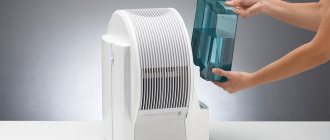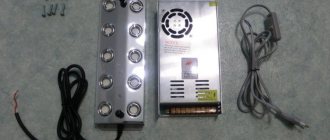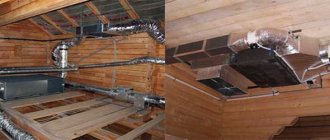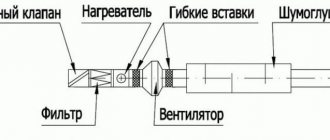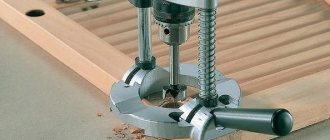It often happens that the air in the house leaves much to be desired. I encountered this while working in the garage. It is located in the basement of the house, it is constantly damp and smells unpleasant, in addition, there is a threat of mold. I had to make an air purifier with my own hands: ready-made options turned out to be too expensive and required regular maintenance. The self-assembled device worked a little worse, but coped with its functions quite well.
Source allstore.com.ua
Washing vacuum cleaner as an air purifier
There are two types of vacuum cleaners that act as air purifiers:
- Vacuum cleaners with aquafilter.
- Washing vacuum cleaners.
Essentially the principle of operation is similar. It's not hard to imagine how the devices turn into an air purifier. We have already described the principle of operation of a cold evaporation humidifier. Vacuum cleaners are not much different, the meaning is the same. Air is sucked in, passes through the water, and then released out through at least two filters. It will come out cleaner than from a humidifier and will contain no less water vapor.
The operating principle of an improvised air purifier is simple. At the entrance to the vacuum cleaner body there are several nozzles located around the channel. Each one throws out a stream of water that washes the incoming stream. In cruising mode, there is expected to be a lot of dirt and debris, but if you use a vacuum cleaner as an air purifier, there will be much less foreign matter. The result is determined by the structure of the filters; some even capture bacterial spores (the size of a unit of micrometer).
It is possible to make an air purifier with your own hands from a suitable vacuum cleaner with an aqua filter. Fill the tank with water. Turn on the device and leave it for half an hour with the brush hanging in the air. This is how a vacuum cleaner for cleaning an apartment turns into a hybrid household appliance - an air purifier + humidifier. There are two disadvantages:
- Vacuum cleaners are noisy. The average air purifier operates at a volume of 53 dB (at maximum power), a vacuum cleaner exceeds this figure.
- The power consumption will leave much to be desired; the vacuum cleaner is not directly designed to clean the air.
At the same time, the quality of cleaning is better than in the case of the humidifier described above. Vacuum cleaners are equipped with HEPA filters at the outlet. This rids the flow of particles 3-5 microns in size in excess of 99%. However, specialized air purifiers operate quietly, consume little energy and are able to free a room even from pathogenic bacteria.
Video reviews, tests and other useful video information
Clean air in your home is essential if you want to stay healthy and have a clear head. Before moving on to information about air purifiers, watch this short video about the air in our home in general and about 5 myths that we are used to believing. After this, your determination to buy a household air purifier will only strengthen.
Well, now the specifics) A short story about air purification devices, what is the difference between a washer, a humidifier and a purifier
Shown using the example of one company, but this is not important. All the most important things are mentioned in the video
What interested me most was a series of real tests of air purifiers. The guys test various models, comparing them with the most effective (but also the most expensive) IQAir (which I immediately wanted to buy!). They are also looking for a cheaper analogue that is worthy of its functions. Will they succeed?
If you want to watch some more tests against the almighty IQAir, then just go to YouTube from the last video. There, under the video there are also links to testing other devices. It's very educational and exciting) I recommend it!
And finally, don’t forget to check the warranty!
The warranty is usually for two years, although you can find air purifiers with a longer warranty. Choose a device from a reliable manufacturer, a well-known brand that will not disappear from the market after a year or two of use
I repeat because this is very important. After all, for an air purifier to work effectively, it is necessary to change/wash the filters throughout the years of operation. That's why it's worth finding out which technology
This manufacturer offers service, what is the availability of spare parts, and most importantly filters! Follow our recommendations and you will buy exactly the air purifier that will make your home fresh and safe.
And you?
Features and benefits
What are the dangers of dry air in an apartment? Insufficient humidity means that dust does not settle, but remains in the air. Dust contains harmful bacteria, mites and microorganisms, so a person may develop allergies or asthma. The nasal cavity serves as a protective barrier against bacteria that linger on the nasal mucosa and leave naturally. Thus, if the nasal cavity is dry, this makes it easier for bacteria to enter the body. Sufficient humidity in the room allows you to maintain the correct condition of the nasal mucosa.
To maintain an optimal level of humidity, there is a special humidifier - a small device that has a simple design and is easy to use. In winter, when heating systems are operating, a humidifier is simply necessary in the room. It can have a beneficial effect not only on the health of the respiratory system, but also improves the general condition of the body, has a beneficial effect on the condition of the skin, and gives a feeling of vigor and lightness.
There are benefits from a humidifier for both plants and pets, while the pet will be healthy and active, and indoor plants will become strong and strong. Perhaps the only disadvantage of an air humidifier is its price. However, this device can be made independently from readily available materials.
Aquarium and fountain
Many people may not like basins of water placed throughout the apartment. But here, too, there is a way out: instead of an ordinary basin with water, there can be any decorative element that contains moisture and gives it the opportunity to evaporate in a warm room. An ideal option, for example, would be a regular aquarium. It will perform both a decorative and moisturizing function. Also popular today are small apartment fountains with or without lighting. They are also able to create a pleasant atmosphere and saturate the air with moisture so necessary for the human body.
Rules for using the device
- The device should not be too noisy; loud noise indicates difficulties with the air supply (the engine “chokes” and begins to operate at high speeds). This may also indicate an unsuccessful fastening of the fan itself.
- The filtration media must be changed periodically; Don't forget about it! A homemade filter will not be able to personally remind you of this procedure! It is recommended to set a notification on your mobile phone about the date for replacing the filter media.
- Try not to leave homemade air purification devices unattended. Any electrical appliance (especially a homemade one) requires special vigilance and care when operating it and, if possible, should not be left unattended. As for homemade air purifiers, they must be supervised throughout the entire period of their operation.
Advantages and disadvantages
Any device has its advantages and weaknesses. Let us consider the photocatalytic “washing” of air from this position.
pros
- Substances entering the filtration system do not accumulate, but are immediately completely destroyed.
- There is no need to change filters because there is nothing left in them. This saves time and money.
- The highest degree of air purification from organic particles and chemical compounds. The device destroys about 99% of toxins. Compared to carbon purifiers, catalyst purifiers are hundreds of times superior.
- Sufficiently high speed of air purification. The device is capable of neutralizing the air in an average living room in 15 minutes.
- Low power consumption.
- Low noise operation.
- Almost instant neutralization of unpleasant odors.
- During the destruction process, toxins are decomposed into ecological, absolutely harmless components.
- Easy to operate and maintain the device.
Minuses
- The bio-filter is ineffective against contaminants of inorganic origin. For example, the cleaner will not destroy concrete dust or synthetic fluff.
- Along with harmful microorganisms, the unit also kills beneficial microbes necessary for the formation of healthy microflora in the body. It should not be used too often.
On a note! Excessive sterility of the air negatively affects the immune system, weakening it. This is especially dangerous for children.
Electrostatic air purifier
The principle of action on air masses is to attract positively charged particles of dust and soot to the negatively charged plates of the unit. If we consider the design of an industrial electrostatic purifier, we can use the diagram to make a similar kind of air purifier or even an ionizer with our own hands. The basic components for such a unit are the following:
- housing with holes for the movement of air masses;
- a filter that creates a high voltage field (ionizing);
- pre-cleaning filter element;
- dust collector with negatively charged electrodes;
- power unit.
The main advantage of such a device is that there is no need to replace the electrostatic filter. For effective operation, it is enough to periodically rinse
it in running (preferably warm) water.
A homemade electrostatic air purifier can be used as an ozonizer
, if left on for a long time. It is able to eliminate bacteria, mold with spores and viruses from premises.
Only no one should be in the room during long-term operation of the device.
Failure to control the amount of ozone emitted makes it unsafe
self-production of an electrostatic cleaner. Preference should be given to store-bought devices from reliable manufacturers.
The use of indoor air purifiers has a positive effect on people's health, mood and quality of life. Available to make with your own hands and easy to use, these devices are a real godsend for maintaining a clean indoor atmosphere in modern non-ideal environmental conditions.
Human health directly depends on the air that enters the lungs. Chemical elements are present in the atmosphere due to emissions from industries, transport and other sources of pollution. To breathe clean air, you can buy an air purifier for your home or make one yourself.
All cleaners work the same. They clean the air from small dust particles. They use a filter through which polluted air passes. After filtration, the fan blows clean air out.
Popular filters:
- aquatic,
- electrostatic,
- coal.
Having two options, buy a device or build it yourself, let’s consider the second of them. You won’t be able to make a multifunctional purifier at home, but you can build a simple model.
Types of air purifiers
Most people try to purchase goods in a store, believing that they cannot be made better than from a factory manufacturer. When the time comes and the DIY repair of an electrostatic cleaner begins, almost everyone is convinced of the simplicity of the design.
Handymen manage to create a powerful air cleaner with their own hands using a bucket with a sealed lid, evaporators and a fan. Moreover, in terms of cost it costs them several times less.
Many live in areas located close to factories, boiler houses, thermal power plants and other smoky industries. It is impossible to stay in a smoke-filled room all the time, and buying a special device is expensive, so self-taught inventors are making a smoke air purifier with their own hands. Fans and carbon filters are used. Non-smokers place miniature, homemade, battery-powered purifiers on their desks.
If you have the desire, you can make the kind of cleaner you need with your own hands, be it electrostatic or the simplest one. Women, knowing about the dangers of dry air, constantly hang a wet towel on hot radiators, but what to do in the summer. The batteries do not work, the heat causes dust and pollen particles to rise in the air, which cause an allergic reaction. That’s when the question of how to make an air purifier becomes especially acute.
Air purification is a top priority, since the health of others depends on it. Therefore, you need to buy an air purifier or decide how to make a purifier yourself in advance so as not to blame the weather and the environment for your well-being. To save money, a homemade air purifier can also work as an air conditioner; you just need to add pieces of ice to the water and the room temperature will drop by 7-8 degrees.
From a cooler and a plastic bottle
You can make an air humidifier with your own hands from a computer cooler (fan) and a plastic bottle - one of those bottles in which drinking water is usually sold. Depending on the size of the cooler, select the container capacity. The bottle must have such a cross-sectional area that a fan can be mounted on it. It would be better if it was 10 liters.
How to make a humidifier at home from these materials:
- Cut off the neck and top of the empty bottle.
- Pour water into it up to half the height of the vessel.
- Install a fan into the resulting hole. For greater density, you can use a piece of thick cardboard, cut a hole in it slightly smaller than the diameter of the cooler and attach it to the bottle, and then attach the cooler to it.
- Secure the fan with tape.
- Connect the device to the electrical network.
When there is very little water left in the bottle, remove the cooler and refill the bottle.
Coal column arrangement
Based on Lowitz's research, coal columns were created in which charcoal was used. And not only from birch, as now. The best alcohols were obtained by passing through coal made from linden, alder, oak and poplar. Beech was also used. Birch has gained popularity due to its low cost and large amount of raw materials.
The column is a cylinder half filled with charcoal. In industrial conditions, such columns (since the end of the 17th century) were 4 meters high and 70 cm in diameter. They were installed one above the other (3-4 pieces) and vodka was passed through them for cleaning. The purification process for one batch took up to 24 hours, and the alcohol was passed through the column sequentially.
At the same time, both the composition (coal took away fusel oils and other impurities) and the taste of the product changed. The vodka became soft and lost its pungent odor. But still the method was not without flaws. New bonds between elements appeared, acetaldehyde, acetic acid and other impurities were formed. To make vodka pleasant to drink, they came up with another method - passing it through a coal column under pressure.
Vodka traveled through coal in less than 1 hour. Various studies have confirmed that this particular cleaning duration is optimal for improving the organoleptics (set of taste and quality properties) of the product. This type of purification involves filtering alcohol under its own weight.
Today they also produce columns with pumps that allow you to quickly purify alcohol-containing liquids while ensuring the quality required by GOST standards.
A new step in improving coal cleaning was the activation of coal with steam. During steam treatment, unnecessary compounds and resins are washed out of burnt wood, and the pores expand, resulting in improved adsorbing properties.
Modern industrial coal columns are large in size and it is impossible to create one at home. Yes, it is not needed for the volumes of moonshine that are produced by distillers. There are compact models, which we will discuss below.
Purification technology
Using a coal column, you can purify moonshine both after the second distillation and during the distillation itself.
The heads and tails are selected separately and the coal is not contaminated with them. The process itself:
- The column is installed with a drain hole above a three-liter jar.
- Fill the cylinder with BAU-A coal to half the height or slightly higher.
- Fill with moonshine if cleaning is carried out after distillation.
- If moonshine is purified during distillation, then after selecting the heads, install a column with coal above the receiving container, cover it loosely with a lid, and connect a hose through which the moonshine is discharged to the fitting. At the end of body selection, the hose is turned off and the tails are collected in another container.
Causes of dampness
Excessive humidity in a living space may appear from time to time or be a constant concern, but in any case it has its own reasons and they must be clarified in order to be eliminated in a timely manner. The appearance of mold and musty smell, and, as a result, respiratory disease, expensive repairs, or the purchase of new furniture, can become a serious punishment for carelessness in relation to sources of dampness in an apartment or house.
The main causes of excess humidity:
- insufficient ventilation or its absence in the room (especially in the kitchen and bathroom)
- groundwater that lies high or rises in the spring (relevant for private houses)
- poor condition of water taps and sewer pipes
- drying washed clothes in living rooms
- a large number of house plants or arranging a greenhouse in an apartment
- the presence of an open water tank (large fountain or aquarium)
- swimming pool or sauna in the house (basement, ground floor or lower floor)
- poor thermal insulation of walls
- insufficient heating of the apartment (low temperatures cause condensation)
The moisture level is measured using a hygrometer. Knowing the humidity standards for a living space (45-60%), you can take preventive measures even before signs of excess moisture and its negative consequences appear.
Popular models
The following installations have proven themselves to be the best in the fight against harmful smoke.
MCK75JVM-K from Daikin
This unit performs five-stage air purification:
- catechin - retains pet hair and large dust particles;
- plasma ionizer;
- electrostatic filter - breaks down formaldehyde, as well as tobacco smoke molecules;
- pleated filter - absorbs and then decomposes bacteria, as well as viruses and other toxic components passed through the other three filters;
- deodorizing catalyst - produces final splitting of air before returning oxygen to the living space.
The device has a silent operation mode. The purifier easily copes with its main tasks, which is especially important if there are smokers in the house.
Technical specifications:
- air mass flow – 450 m3/h;
- suitable for rooms up to 46 m2;
- weight – 11 kg.
These models have one drawback - they cannot be called cheap. The cost of installation in stores starts from 45 thousand rubles.
Panasonic F-VXF70
A good air purifier model that does an excellent job of removing cigarette smoke. The cleaning system includes water, deodorizing, and combined filters. This model effectively neutralizes strong odors and smoke, destroys harmful microorganisms, and also additionally humidifies the air.
Technical specifications:
- air mass flow - 400 m3/h;
- area – up to 52 m2;
- weight – 10 kg.
Boneco 2055D
Quiet, compact, but at the same time high-quality water filter from the budget segment. It is highly effective in controlling cigarette smoke and strong odors. The general purification of air from other dangerous microelements is also excellent.
Technical specifications:
- water consumption – 250 ml/hour;
- optimal for rooms within 50 sq. m;
- weight – 6 kg;
- capacity – 7 l.
DIY air purifier
To produce a simple cleaning device with a carbon filter, you will need to stock up on:
- miniature fan operating at 12 V;
- Krona battery and terminal for it;
- a plastic box, the size of which will allow you to install a fan inside it;
- carbon filter.
DIY air purifier
The box will serve as the body. A fan is needed to circulate the air mass being purified; a battery is required to power the cooler. This means that holes need to be made on the housing to connect the battery and to ensure free flow of air to the carbon filter, the flow of which will stimulate the fan.
Using a marker on the plastic box, we will mark the lines of future cuts for the intake and exhaust of purified air on the lid and bottom, for connecting the supply element in the center of the bottom edge.
Saw holes along the marked lines
Carefully saw holes along the marked lines.
The battery will be connected to the fan using a terminal. It is better to use solder to increase the reliability of contact.
The battery will be connected to the fan using a terminal
The terminal must be glued to the fan, and then the functionality of the created “node” must be checked.
Having received confirmation of a correctly completed connection, we install all the elements in the housing box.
Having received confirmation of a correctly completed connection, we install all the elements in the housing box.
In accordance with the dimensions of the box, we cut out the carbon filter. It needs to be placed on top of the fan.
Cutting out the carbon filter
So the homemade air purifier is ready, the assembly of which took a minimum of time and no special money or effort was spent.
Application in industrial premises
Clean air is necessary not only at home, but also at work. The environmental situation at the location of the enterprise depends on this. In production facilities, main compressed air filters are used, which have a large throughput and a high degree of purification. Industrial filters consist of fibers distributed in such a way that dirt particles accumulate as they pass through their layers. Cleaning devices used in the industrial sector can be divided into 2 types:
- preliminary – deep electrostatic and dry fine fiber;
- mesh - equipped with irrigation and capable of self-cleaning.
To normalize the operation of the ventilation system in industrial premises, a special filter and air pressure regulator is installed to lower the air pressure in the line and maintain it in a certain range.
The use of activated carbon filters is very extensive, since human health completely depends on the cleanliness of the air and the sorbing properties are undeniable. Even a car will not move without oxygen purified to the proper level. Dust and harmful gases are constantly floating in the air, so you shouldn’t skimp on your own health and install a carbon air filter. Not only the kitchen needs an exhaust device; any room deserves an air filter for an apartment or a private house.
Apartment residents do not always think about an air purifier, but over time they notice that it is simply necessary. First of all, it makes the microclimate in the house cleaner, and also becomes an assistant in the fight against allergies and the prevention of many diseases. The ecology in big cities leaves much to be desired, and in addition to dust, bacteria and cigarette smoke are in the atmosphere, it becomes difficult to breathe, residents suffer, but not everyone notices the side effects.
In any case, an air purifier will help cope with harmful substances, and it is also perfect for allergy sufferers. As a rule, such devices are sold in special stores, but with the help of some manipulations you can make it yourself.
Helpers in the fight against dust
Special devices and products that can be bought at any store will help you get rid of dust in your apartment. These include:
Humidifier
In a room with humidified air, it is much easier to combat dust. Dust stops flying randomly in the air and settles on the floor and furniture, where it can be quickly removed with a rag or vacuum cleaner.
Vacuum cleaner
A vacuum cleaner with an aqua filter will allow you to remove dust not only from the surface being treated, but also from the air. Thanks to a good vacuum cleaner, a dust-free room will sparkle with new colors.
Chlorophytum
A plant that, according to knowledgeable people, can reduce the amount of dust in a room.
Hygrometer
A hygrometer is used to monitor the humidity in the home. If the humidity level is exceeded, ordinary household dust can turn into a dangerous reagent, not to mention the appearance of mold.
Membranes for windows
Devices that protect your home from dust particles and dangerous allergens entering it from the street. High-quality window membranes prevent bacteria, pollen, smog, insects, mold, etc. from entering your home.
"Air washing"
A modern device that passes all the air in the room through itself and cleans it of dust particles. “Air washing” is especially effective in homes where dust is difficult to get rid of using available means, for example, in recently renovated premises and new buildings.
When choosing an “air washer”, pay attention to the area of the room and the goals you set for yourself. So, some devices effectively humidify the air, others help get rid of bacteria and unpleasant odors, and others ionize the air in the apartment and disinfect it. If you want to get rid of dust, it is recommended to buy those “washers” that effectively cope with the tasks of purifying and humidifying the air
If you want to get rid of dust, it is recommended to buy those “washers” that effectively cope with the tasks of purifying and humidifying the air
So, some devices effectively humidify the air, others help get rid of bacteria and unpleasant odors, and others ionize the air in the apartment and disinfect it. If you want to get rid of dust, it is recommended to buy those “washers” that effectively cope with the tasks of purifying and humidifying the air.
Simple air humidification options for your home
It is not at all necessary to spoil the interior by hanging wet towels over all the radiators (although this is also an excellent effective option, but it spoils the paint on the radiators). In order for moisture to enter the air, it must evaporate, and the more sources of water there are in the house, the better.
- Aquarium.
- Pots with flowers (when there are really a lot of them, a tropical microclimate can be felt in the house or apartment).
- Vases, beautiful glasses, etc., standing on the windowsill near the radiator.
- Decorative fountains and compositions containing water.
- Do not close the door to the bathroom - it needs ventilation, and its moisture will be useful in the rooms.
Do not forget that regular wet cleaning removes dust and adds moisture, and you can also periodically spray water with a spray bottle, but this should be done away from equipment.
The disadvantage of such methods is that they do not last long. Small containers quickly run out of water, the towel needs to be wetted again and again, and the decor and aquarium require care, otherwise microorganisms will breed in them.
Cleaner for dry environments
When considering how to make an air purifier with your own hands, you should start with a category of devices called washers. During the heating season, the risk of dry air increases. Radiators, convectors, stove heating, etc. contribute to rapid loss of moisture. Therefore, equipment such as a filter washer should be used.
To create this equipment, you will need to prepare a spacious plastic container, a computer cooler or a small fan, and distilled water. The system will operate from the network. Therefore, you will need to prepare a power supply for the fan.
A hole for the cooler is cut out on the lid of the container. It should be secured with screws. The design must be reliable. If the cooler falls into water, a short circuit will occur. Several holes should be made on the top of the container. Water is poured into the pan so that there is at least 3 cm from the fan. The electrical circuit is assembled and connected to the network. The device will absorb contaminants in the air, making it cleaner.
General Approach to Engineering a Home Purifier
- The housing has slots for the intake of dirty air and the removal of clean air masses.
- Cleansing and ionizing filter.
- A dust collector consisting of installed electrodes with oppositely polar charges.
- Electronic controls for automatic control.
- Power supply to start the device.
Electric air purification: operating principle
Charging particles
charging Diffusion charging Charging processes
- the ability of a particle to charge (charging speed and the maximum charge beyond which the particle cannot charge);
- time allotted for the charging process;
- electrical parameters of the region in which the particle is located (electric field strength, concentration and mobility of ions)
Drift and particle deposition
- electrostatic forces of attraction due to the presence of a charge on the particle;
- molecular forces;
- forces due to capillary effects (in the presence of a sufficient amount of liquid and the ability of the particle and electrode to be wetted).
- production of positive ions to charge particles;
- providing an electric field for the directed drift of ions (necessary for charging particles) and for the directional drift of charged particles to the precipitation electrode (necessary for particle deposition).
- high quantitative concentration of pollutant particles; leads to a deficiency of ions (most of them are deposited on particles), as a result of which the intensity of corona decreases, until it stops (the phenomenon is called corona locking), deterioration of the electric field parameters in the gap; this leads to a decrease in the efficiency of the charging process;
- accumulation of a dust layer on the collecting electrode: if the layer has high electrical resistance, then an electrical charge of the same sign as the charge of drifting particles (and the polarity of the corona electrode) accumulates in it, resulting in: the intensity of the corona discharge decreases (due to the deformation of the electrical fields in the gap), which negatively affects the process of particle charging and the process of particle drift to the collecting electrode;
- the charged layer has a repulsive effect on the deposited particle, which has a charge of the same sign, which negatively affects the deposition process;
Price
You can buy an air washer inexpensively at almost any hardware store. The price of the cheapest options is approximately 1,500 rubles . You can also find small USB devices in hypermarkets or order from online stores, which also have a low cost ( from 1000 rubles ).
, main types.
The price of more advanced models reaches 17,000 rubles . If you make it yourself, the price of all materials will be about 600-1000 rubles .
Humidity control
How to solve the problem with humidity control? Factory dehumidifiers are equipped with built-in sensors to control air temperature and humidity. But what about a homemade device? You can use a thermometer, but it is not necessary and will not tell you anything about the humidity level.
Use a hygrometer. It can be arrow or digital. You can buy it in many specialty stores. In addition, such a device is often included in the design of some modern watch models.
A hygrometer will help you control indoor air humidity
When using a homemade dehumidifier, do not forget that too dry air can be harmful. After all, in addition to pathogenic organisms, there are also beneficial bacteria around us that also need moisture. A hygrometer will help you determine if you need to use a dehumidifier. If the humidity in the apartment has reached a critical 80%, at which mold and fungi begin to actively multiply, feel free to turn on the device
Pay attention to weather conditions: in some cases it may be necessary to use a humidifier rather than a dehumidifier
As you can see, you can easily make a dehumidifier yourself. This solves another problem - using an old refrigerator, which is a pity to throw away and has nowhere to put it. Share with us your experience in dehumidifying the air in your apartment. Easy work for you and comfort for your home!
How to get rid of tobacco smoke
In practice, several methods are used to create a normal microclimate for people who are forced to be near smokers.
- Use of air purification equipment.
- Fencing the smoking area.
- The use of hoods with the removal of contaminated air into the ventilation system.
- Creation of specialized room ventilation systems.
Each of the methods has been tested in practice and has the right to life. Next, we will consider each method, its advantages and disadvantages in more detail.
Air purifiers
You can clean the air in a single room using devices equipped with specialized filter elements, devices that purify the air mixture at the molecular level. Equipment that can be used to get rid of the smell of tobacco smoke includes a regular kitchen exhaust hood, as well as a portable hood for smoking at home.
- Air purifiers equipped with carbon electrostatic filters will effectively clean the air mixture from the smell of tobacco only in case of prolonged operation in a closed room. The cost of carbon filter elements, depending on the model of the device, is quite high, so replacing them regularly will make the smoker happy.
- An air ionizer can clean the air masses of a small and enclosed room from contaminants. Without going into technical details, tar and nicotine in the air, under the influence of ions, lose their volatility and settle on the floor. What happens next: after turning off the device, all contaminants, under the influence of air currents that are present in each room, will inevitably enter the lungs and blood.
Required materials and manufacturing steps
Let's look at step-by-step instructions for assembling a simple air purifier from a fan with your own hands. For this you will need:
- any plastic container with a lid;
- fan, its power should be low, you can take an old cooler from a computer;
- pure water;
- handy tool.
Having prepared everything you need, we begin assembling a homemade air purifier:
- install the fan on the container lid. It is necessary to take into account that it must fit tightly and be firmly secured. Otherwise, due to its own vibration, the fan will become loose and fall into the water, which will, at best, lead to a short circuit;
- pour water into the container. The level should not reach 3-5 cm from the cooler blades;
- close the lid.
This simple DIY water purifier starts working immediately after being plugged into the network. You can put a carbon filter in it for additional cleaning, or add silver or flavoring to the water, then the air in the room will be saturated with silver ions and incense. The main thing is to constantly monitor the water level; for this, you can provide a window for topping up.
Another more cost-effective one is the DIY CD air washer, which is more difficult to make. Every family has a certain number of old worn-out disks, but in order to use them they must be brought into proper condition. To assemble an air washer from plates with your own hands, you need:
- sand with a machine or a roughing brush to bring the discs for air washing with your own hands to a rough state, since moisture does not linger on the glossy surface;
- solder pieces of plastic washers along the edges of the disks, acting as scoops;
- find a rectangular plastic container and install small fans on 3 sides, you can use computer fans connected in series;
- Place the required number of plates on a plastic pipe, the diameter of which is selected according to the hole in the disk. You can use a pipe for electrical wiring;
- in order for there to be good filtration and do-it-yourself air washing with water to work correctly, it is necessary to place plastic washers up to 3 mm thick between the disks;
- discs pulled together on a shaft are installed in a container and set in motion using a small motor from a toy;
- the container is filled with water to the level of the fans;
- There is a hole on the side for refilling.
In this homemade air washer, the fans installed on top work to draw in, and the side fans push out the humidified environment.
How to make a carbon filter
But after the announcement of the coronavirus pandemic and the announcement of quarantine measures, it became difficult to purchase factory-made carbon filters. They are completely out of stock or cost several times more than the original price.
In order not to be left without protection during difficult quarantine times, folk craftsmen suggest making a filter layer with your own hands. Before starting work, we would like to note that such filters have not passed clinical tests. Their effectiveness has not been proven.
Step-by-step manufacturing instructions:
- Prepare 6 layers of non-woven material according to the size of the mask. For example, spunbond. It is sold in gardening stores.
- Several tablets of activated carbon are thoroughly crushed and evenly distributed between the layers of spunbond.
- The workpiece is sewn along the edges.
- To prevent the coal from falling off, the filter is stitched lengthwise and crosswise. The more stitches you make, the more evenly the charcoal will be distributed while wearing.
- If necessary, trim the edges without damaging the areas with coal.
Non-uniform electric field
heterogeneous
Corona discharge
- in a small area close to the wire electrode, the electric field strength can reach high values (significantly exceeding 30 kV/cm), sufficient for the occurrence of intense ionization processes in the air;
- At the same time, in most of the interelectrode space the electric field strength will take low values - less than 10 kV/cm.
corona discharge corona electrode ionization zone (or discharge cover) drift zone corona discharge current avalanche streamer
Experiment #3
| U, kV | I, µA |
| 6,5 | 1 |
| 7 | 2 |
| 8 | 20 |
| 9 | 40 |
| 10 | 60 |
| 11 | 110 |
| 12 | 180 |
| 13 | 220 |
| 14 | 300 |
| 15 | 350 |
| 16 | 420 |
| 17 | 520 |
| 17.1 | overlap |
Experiment #4
| U, kV | I, µA |
| 7.5 | 1 |
| 8 | 4 |
| 9 | 20 |
| 10 | 40 |
| 11 | 100 |
| 12 | 150 |
| 13 | 200 |
| 14 | 300 |
| 15 | 380 |
| 16 | 480 |
| 17 | 590 |
| 18 | 700 |
| 18.4 | 800 |
| 18.5 | overlap |
Experiment #5
| U, kV | I, µA |
| 5.5 | 1 |
| 6 | 3 |
| 7 | 10 |
| 8 | 20 |
| 9 | 35 |
| 10 | 60 |
| 11 | 150 |
| 12 | 300 |
| 12.9 | 410 |
| 13 | overlap |
- geometric parameters of the interelectrode space: geometric parameters of the corona electrode;
- interelectrode distance;
- chemical composition;
: Installation of electronic components
You will need the following components:
- Switch
- Voltage regulator to reduce voltage from 12V to 5V for microcontroller
- Microcontroller - needed to control speed
- Variable resistor, gives the microcontroller an analog output to control the speed of the fans
- Transistor for switching 12V
I used a small breadboard to install all the components. First I made the circuit diagram, then started placing the components on the breadboard.
The power connector, variable resistor, diode and switch were attached to the side part with holes prepared for this, connected to the board, and the wires on the back side of the board were connected into a circuit and secured with clamps.
A diode in the motor circuit prevents back-EMF from damaging the microcontroller. Make sure that the diode you choose will last a long time and ensure stable operation of the system.
After the proprietary program has been entered into the microcontroller, you need to check the operation of the system and only then complete the assembly of the device.
Rules for operating such equipment
Do not forget that when operating the device, you should pour either distilled water or liquid passed through a good water filter to remove salts into the container. In addition, no matter what kind of humidifier you make (or buy), with the exception of devices where steam is formed as a result of boiling liquid, you should be aware of the danger of legionellosis. This is an acute infectious disease, which in its symptoms initially resembles influenza or ARVI, causing severe pneumonia - pneumonia, also called “Legionnaires' disease”. Such pneumonia often has a severe and malignant course, and can be fatal.
This disease is caused by the bacterium Legionella, which multiplies very well in warm and humid environments (water). Infection can occur:
- if a person inhales air from an uncleaned air conditioner (meaning centralized systems with air ducts in which moisture accumulates),
- inhales the moist air in the showers,
- is located in a room where a humidifier or air washer operates, in which the water has not been changed for a long time and the container for it has not been disinfected,
- inhales an aerosol from water while being near a fountain, etc.
Therefore, the water in your device needs to be changed every day, and the container itself must be rinsed well under running water. In addition, 1-2 times a week, the container should be treated with disinfectant solutions. Do not forget to thoroughly rinse the container after treatment so as not to inhale the vapors of the disinfectant solution when operating the device. You can read more about the nuances of operating such devices here.
Humidifier with antibacterial filter
For such a device, you naturally need a filter, in addition, a low-speed fan (12V) and a plastic box.
A moisturizing sponge with antibacterial impregnation is a key part of such a humidifier; it is capable of trapping large particles, dust and hair. Impregnation prevents germs from spreading.
The assembly process is not particularly difficult. In a plastic container, you need to make a cutout in the side about half the height of the filter, then it needs to be secured with a plastic tie or any other way.
A fan is attached to the lid of the container, for which a hole is cut out prematurely. The last stage is pouring water; its level should be slightly lower than the height of the side slot. Everything is ready, all that remains is to plug it into the outlet.
Do not forget that such a filter needs to be changed regularly; this need can be seen by its color - it darkens, but at least once every three months.
Another version of the humidifier will have a similar design, only instead of a filter there will be gauze, and for the convenience of pouring water, you can make a hole in the container lid with the same diameter as the neck of a watering can.
Its advantage is that there is no need to purchase a filter. For an additional effect, you can add a few drops of essential oil to the water, which will provide both moisturizing and aromatization.
Decorative air humidifier
All these designs are not very attractive, but if you crave aesthetics in everything, then this humidifier option will suit you.
In order to make it, you need to take a bowl, preferably blue or light blue. You can stick pebbles inside it and on the edges using special glue; if you have plastic fish, then they will go too - in general, to create a marine ambience, you can throw pebbles on the bottom. Fill the whole thing with water and place it near the battery.
Required materials and manufacturing steps
Let's look at step-by-step instructions for assembling a simple air purifier from a fan with your own hands. For this you will need:
- any plastic container with a lid;
- fan, its power should be low, you can take an old cooler from a computer;
- pure water;
- handy tool.
Having prepared everything you need, we begin assembling a homemade air purifier:
- install the fan on the container lid. It is necessary to take into account that it must fit tightly and be firmly secured. Otherwise, due to its own vibration, the fan will become loose and fall into the water, which will, at best, lead to a short circuit;
- pour water into the container. The level should not reach 3-5 cm from the cooler blades;
- close the lid.
This simple DIY water purifier starts working immediately after being plugged into the network. You can put a carbon filter in it for additional cleaning, or add silver or flavoring to the water, then the air in the room will be saturated with silver ions and incense. The main thing is to constantly monitor the water level; for this, you can provide a window for topping up.
Another more cost-effective one is the DIY CD air washer, which is more difficult to make. Every family has a certain number of old worn-out disks, but in order to use them they must be brought into proper condition. To assemble an air washer from plates with your own hands, you need:
- sand with a machine or a roughing brush to bring the discs for air washing with your own hands to a rough state, since moisture does not linger on the glossy surface;
- solder pieces of plastic washers along the edges of the disks, acting as scoops;
- find a rectangular plastic container and install small fans on 3 sides, you can use computer fans connected in series;
- Place the required number of plates on a plastic pipe, the diameter of which is selected according to the hole in the disk. You can use a pipe for electrical wiring;
- in order for there to be good filtration and do-it-yourself air washing with water to work correctly, it is necessary to place plastic washers up to 3 mm thick between the disks;
- discs pulled together on a shaft are installed in a container and set in motion using a small motor from a toy;
- the container is filled with water to the level of the fans;
- There is a hole on the side for refilling.
In this homemade air washer, the fans installed on top work to draw in, and the side fans push out the humidified environment.
The discs are half immersed in water and rotate, constantly being wetted. The fan, in turn, promotes faster evaporation of moisture from the surface of the disks
Traditional methods
Coffee grounds are a great refrigerator deodorizer. This is one of the natural ways to get rid of the smell of spoiled food caused by a broken freezer. Simply fill a cup with coffee grounds and place it in the freezer overnight. The coffee grounds will absorb the smell. You can add a couple of drops of vanilla to the grounds.
Lemons and oranges are great for home deodorizing. Never throw away the peels of these fruits. They can be used to wipe cutting boards and countertops. Place it in the kitchen and other places. And when dry, burn in the fireplace and boil with a little water.
Salt has the ability to neutralize unpleasant odors. Pour a salt solution into the drain if there is an unpleasant odor.
Instead of store-bought air fresheners, place clove buds or a cinnamon stick in a pan of water and simmer over low heat for half an hour.
You can turn on the oven and put a saucer with spices. Leave the door open to fill the house with the aromas of herbs and spices.
Eucalyptus has antifungal and antibacterial properties. Place branches of the plant in places where there is a musty smell.
From CDs
The photo below shows how the air washer looks from the inside in its factory version.
Cleaning and humidification occurs due to the use of a large number of plastic discs in the unit, which increases the area of moisture evaporation and the area of contact with the air flow. Thanks to this, the unit works like a water air purifier, since most of the dust sticks to the discs and is washed into the water in the pan. A similar design can be made at home from CDs.
You also need to select the axis on which these disks will be strung. There are many options for what this shaft is made of: it can be a plastic tube of a suitable diameter or a metal tube, but the simplest solution that can be bought on the market is a 10 mm diameter pin with a thread.
You will also need to purchase the required number of washers (you can make it yourself from a piece of plastic), 2 bearings with a suitable seat diameter and nuts.
Next, follow the given algorithm for performing the work.
- Using sandpaper, a sanding wheel or a drill attachment, remove the top (shiny) layer from the discs so that they become rougher and better wetted with water.
- Place the discs on the stud, placing washers between them.
- Secure the discs to the edges of the shaft using nuts. If you are using a plastic tube, then the discs are secured using a plastic washer and a glue gun.
- Place the bearings on the ends of the shaft and secure them with nuts (in the case of a plastic axle, they are glued with a glue gun).
- A pulley must be secured on one side of the shaft. It can be made from three disks glued together, the central one having a diameter 2-3 mm smaller than the side ones. This pulley will be fitted with an elastic band for money.
But before assembling the shaft with disks, it is necessary to decide on the container on which this entire structure will be installed. The length of the shaft should be such that the bearings extend beyond the container and are installed on the corners glued to it, as in the following figure.
It is also necessary to calculate the location on the shaft where the pulley will be attached. It must be located strictly opposite the motor pulley so that the belt does not fly off.
As a sink body, you can use a plastic container with a lid into which a computer cooler is mounted.
To connect the fan to the network, if you are not good with electronic circuits, you can use any ready-made 12V power supply.
: Assembly
Coolers need to be fixed on the two large sides of the case, and on one sheet the coolers should be directed outward, and on the other - inward. This is necessary so that the air flow passes through the filter. On which sheet where they will be directed does not matter, the main thing is that all four on the sheet look in the same direction.
After making sure that the cooler wires are positioned correctly, you can secure two opposite corners of all coolers. In the other two holes we will attach protective grilles from the coolers from the outside.
Once all the coolers are secured, gather all the wires together and secure them with cable ties. If the wires are in the winding, remove it. You and I are only interested in red and black wires - all red ones should be with red ones, and black ones with black ones, wires of other colors can simply be cut off.
I screwed 12 M3 bolts onto one side and screwed the extended nuts onto them. Once all the coolers are in place, you can begin installing the electronics.
Useful tips
Experts recommend paying attention to the following aspects:
- Before making your own purifier, be sure to check the humidity level in the room. A hygrometer is used for this.
- Choose the power of the ventilated appliance correctly. To serve a space of 20 sq. m is enough 5-15 watts.
- Change water and moisture absorbers frequently.
- Use exclusively purified or distilled water.
- If the air in the apartment is too dry, additionally use other methods of humidification - leave water in containers open, evaporate the liquid, install an aquarium with fish or an artificial fountain.
- In case of high humidity, turn on floor or table fans, and open windows in dry weather. Turn on heating appliances.
Smart ventilation Tion MagicAir - fresh air while you sleep!
MagicAir is a new level of comfort in creating an ideal microclimate. We are talking about a high-tech device that evaluates the current air parameters in your apartment and provides autonomous control of climate control equipment.
This problem can be solved in three simple steps:
The first is the installation of a compact and “smart” supply ventilation breather Tion O2 MAC, which will provide a constant supply of fresh air, its thorough cleaning and heating.
The second is connecting and placing a MagicAir station, which will establish a wireless connection with the breather via the Internet. Now you can receive air quality data on your smartphone and remotely control the microclimate in your apartment.
Third , set your parameters for the CO2 content in the air and the breather will automatically maintain the optimal level of ventilation for you.
Frame
The fan is mounted inside the housing, which is made of laser-cut 5 mm plywood. Since the fan itself is heavy, and a strong base is needed to attach the filter, the lower part of the housing is reinforced with wooden elements. They were cut the same length, but did not fit perfectly tightly. I used wood putty to fill the voids and seal the system.
Outlet
Since I used foam material to dampen fan vibrations, it was difficult to immediately determine the location of the outlet. I cut it myself using a drill. Not very carefully, but it won't be visible.
Fan mount
Foam material was used wherever the fan came into contact with anything to insulate the noise. Given the heaviness of the fan, it had to be mounted on two surfaces. A laser cut frame will be used for the exit hole. The bolts come out. I did it this way because I made a noise isolator for the outlet and the bolts sticking out will help in securing it.
Housing sealing
To ensure that the low pressure chamber was filled with air only through the filter, I used wood putty to seal it. The electrical outlet is another weak point. I drilled a hole smaller than the diameter needed for the wire, and enlarged it a little with a needle file. This made everything more accurate.
Electrical box
I glued the electrical box to the back of the case. Since the fan is not adjustable, I installed a simple two-position switch. To allow air circulation in case of overheating, I drilled several holes in the sides of the box, which is not the best option.
Climatic conditions
Before you start working on creating an air purifier with your own hands, it is very important to determine the climate in the apartment or house where it will be used. A device for measuring air humidity will help with this.
For example, if the air humidity in the room is satisfactory, the only concern is dust, then it is quite possible to use a car filter.
But if the air in the house is dry, then the task becomes a little more complicated.
Dry room
If the air is dry, it is more advisable to try to humidify it, because such climatic conditions are not suitable for normal stay indoors. Dry air affects your well-being: fatigue increases, attention and concentration deteriorate, and immunity decreases. Prolonged stay in a dry room is dangerous for the skin - it becomes dry and susceptible to premature aging.
Please note: acceptable humidity for humans is 40-60%, these are the indicators that need to be achieved.
Step-by-step instructions will help even a beginner build an air purifier. The main thing is to carefully follow the instructions and prepare the necessary elements.
- We prepare the parts: a plastic container with a lid, a laptop fan (it’s called a cooler), self-tapping screws, fabric (microfiber is best), fishing line.
- We take the container and make a hole in its lid (to fit the cooler, it must stand tightly).
- We screw the fan to the lid of the container (you will need self-tapping screws for this).
- Pour water into the container so that it does not touch the cooler. Close the lid. We take the power supply and connect the fan to it: 12 V or 5 V units are suitable, but a 12-volt fan cannot be connected directly to a home outlet.
- We place the fabric inside the plastic container (to easily place it inside, we use a fishing line for this - we stretch it in several rows across the air movement).
- We place the fabric so that it does not touch the walls of the container, and air can pass to the exit. All the dust will thus remain on the fabric.
Tip: To make cleaning more effective, make additional holes to place the cloth on the side walls of the container above the water level.
If you put silver in water, the air will be saturated with silver ions.
Damp room
Everything is clear with a dry room - it negatively affects a person. But an apartment with high humidity is no better. Device readings exceeding 70% negatively affect not only people, but also furniture. A humid environment is favorable conditions for the growth of bacteria, fungi, and mold. Microbes release large amounts of spores into the environment, and they enter the human body. As a result, constant illnesses and complaints about health.
Please note: to eliminate excess moisture, it is necessary to ventilate the room, because it can lead to confusion, seizures and even fainting.
To combat high humidity, it is advisable to make the necessary device that will help dry the air.
- When making a purifier, the same instructions apply as for a dry air purifier, the only difference is the fan. It should be 5 V power.
- We also add a component such as table salt to the design. First dry it in the oven. Pour the salt into the container so that it does not touch the cooler.
- The water must be changed for every 3-4 cm layer of salt.
Tip: the salt can be changed to silica gel (the kind you saw in the box when you bought shoes), it absorbs moisture better, however, if there are children in the house, it is not recommended to use it, as they can be poisoned.
